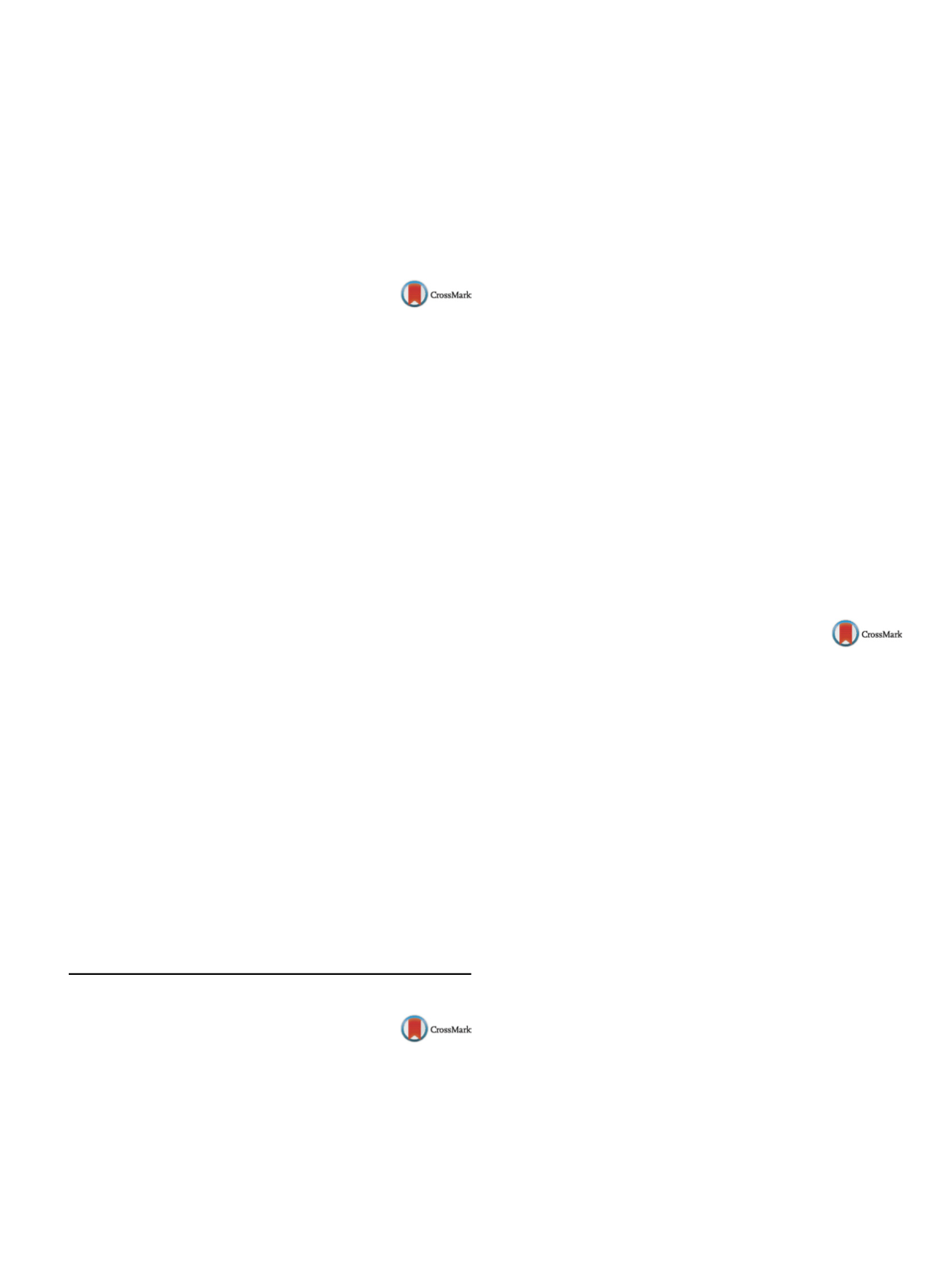

25th European Congress of Psychiatry / European Psychiatry 41S (2017) S303–S364
S315
Conclusions
ED is an iceberg top, of a three-step ladder. The inter-
mediate step is built of personality traits and disorders forging the
variety of ED clinical expressions. The hidden base of iceberg is
represented by both the emotional (de)regulation and the level
of impulsivity. Therapies focused on the base of this iceberg are
needed for a clinical resolution of eating symptoms.
Disclosure of interest
The authors have not supplied their decla-
ration of competing interest.
http://dx.doi.org/10.1016/j.eurpsy.2017.02.224EW0611
Benefits of antidepressant treatment
after a stroke
O. Zerriaa
∗
, O. Moula , S. Ben Saadi , I. Jelalia , R. Ghachem
Razi hospital, B, Mannouba, Tunisia
∗
Corresponding author.
Introduction
Stroke is an important cause of morbidity and is
responsible for 9% of all deaths worldwide. The most frequent
neuropsychiatric consequence of stroke is post-stroke depression
(PSD). It has been shown to be associated with both impaired reco-
very and increased mortality. The aim of our study is to determine
the benefits of antidepressant prescription after a stroke.
Method
The databases from
Medline
and
PubMed
were reviewed
for articles related to post-stroke depression (PSD), antidepressant
treatment and stroke, post-stroke depression and functional reco-
very, stroke related impairment.
Results
Antidepressant drugs have been shown to be effective
in treating PSD in six double blind randomized studies. Patients
treated with antidepressants had better recovery from disability
than patients who did not receive antidepressant therapy: it was
proved that antidepressant drugs cause an improvement in cogni-
tive skills and functional recovery in PSD patients. In patients with
ischemic stroke and moderate to severe motor deficit, the early
prescription of fluoxetine with physiotherapy enhanced motor
recovery after 3 months. Some studies showed that PSD can be
effectively prevented: nortriptyline, fluoxetine, milnacipran and
sertraline appeared to be efficacious in preventing depression after
stroke and are to use without significant adverse effects in stroke
patients.
Conclusion
Antidepressant treatment plays an increasing role in
the management of patients with acute stroke. Therefore, early ini-
tiation of antidepressant therapy, in non-depressed stroke patients,
may reduce the odds for development of PSD, and improve cogni-
tive and functional recovery.
Disclosure of interest
The authors have not supplied their decla-
ration of competing interest.
http://dx.doi.org/10.1016/j.eurpsy.2017.02.225e-Poster Walk: Consultation liaison psychiatry
and psychosomatics - Part 2
EW0612
Polypharmacy among elderly
populations
I. Leal
1 ,∗
, P . Ordás
2 , R. Vicente
1 , C. Avila
21
Hospital de la Princesa, psychiatry, Madrid, Spain
2
Universidad Autonoma Madrid, psychiatry, Madrid, Spain
∗
Corresponding author.
Introduction
Potentially inappropriate prescribing, is highly pre-
valent among older patients hospitalized with major psychiatric
illness. Inappropriate use of psychotropic medications in elderly
patients has become a focus of concern.
Objectives
To determine the prevalence of potentially inappro-
priate prescribing including potentially inappropriate medications
(PIMs) and potential prescription omissions (PPOs), accor-
ding to STOPP-START, Beers and PRISCUS criteria applied by
CheckTheMeds
®
.
Aims
To identify potentially IP, PPo and the prevalence of
contraindications, interactions and precautions in older patients
hospitalized with major psychiatric illness.
Methods
Retrospective cross-sectional study with patients over
65 discharged from the Psychiatric acute unit of the university
hospital of La Princesa (Madrid) between January 2013 and Octo-
ber 2015 was conducted. The CheckTheMeds
®
program was used
to identify IP.
Results
A total of 104 elders–74 females and 30 males–were
included, with a mean age of 76 years (range: 65–91). An average of
5.73 (range: 1–16) was prescribed drugs at discharge. The Ip results
STOPP 81.73% (
n
= 85), START 43.26% (
n
= 45), Beers 94.23% (
n
= 98)
y PRISCUS 40.38% (
n
= 42). Contraindications were described in
the 21.15% of the patients, precautions in 83.65% and interactions
in 83.65%. Psychotropic drugs were the most often inappropriate
prescribed medicaments.
Conclusion
Prescribing omissions are twice as prevalent as IP in
the elderly. Currently, inappropriate prescription of psychotropic
agents is very common for the elderly. Application of such screening
tools to prescribing decisions may reduce unnecessary medication,
related adverse events, healthcare utilization and cost and non-
pharmacological interventions, should be thoroughly explored.
Disclosure of interest
The authors have not supplied their decla-
ration of competing interest.
http://dx.doi.org/10.1016/j.eurpsy.2017.02.226EW0613
To the question of the role of
consultation liaison psychiatry in
diagnostics of psychosomatic
disorders
V. Lebedeva
∗
, O. Pavlova , E. Yurovskaya
Mental health research institute, Tomsk national research medical
center of RAS, Clinic, Tomsk, Russia
∗
Corresponding author.
Background
Relevance of consultation liaison psychiatry is
conditioned by trend of steady rise of psychosomatic disorders and
insufficient development of supplied forms andmethods ofmedical
care to patients with this pathology.
Aim
To study incidence rate of psychosomatic disorders in pri-
mary health care, to develop algorithm of medical care.
Material and methods
A total of 2010 patients of the primary
health care unit were examined. Methods used: clinical-
psychopathological, clinical-dynamic, questionnaire screening,
statistical (factor analysis).
Results
Mental disorders, co-morbid with physical pathology,
constituted 3.9% of the contingent with predominance of psycho-
somatic disorders–15.6 per 10,000 of the population. Respective
from clinical-dynamic structure of psychosomatic disorders three
groups of patients were distinguished: in need for consultation
by a psychiatrist (22.9%); for course treatment by psychiatrist
and subsequent observation by physicians (28%); and for syste-
matic therapy and observation by psychiatrist (49.1%). Patients
with psychosomatic disorders addressed general medicine net-
work 1–2 years after onset of mental disorder and 6.4
±
1.2 years
after diagnostics of somatic pathology. Patients had predomi-
nantly cardiovascular (37.7%;
P
< 0.05), respiratory (20.5%), and
gastrointestinal diseases (20.9%). Exacerbation of psychosomatic
disorder was reliably interrelated with psychotraumatic situation
and exacerbation of physical pathology. Introduced algorithm of
psychiatric consultation consisted of:


















